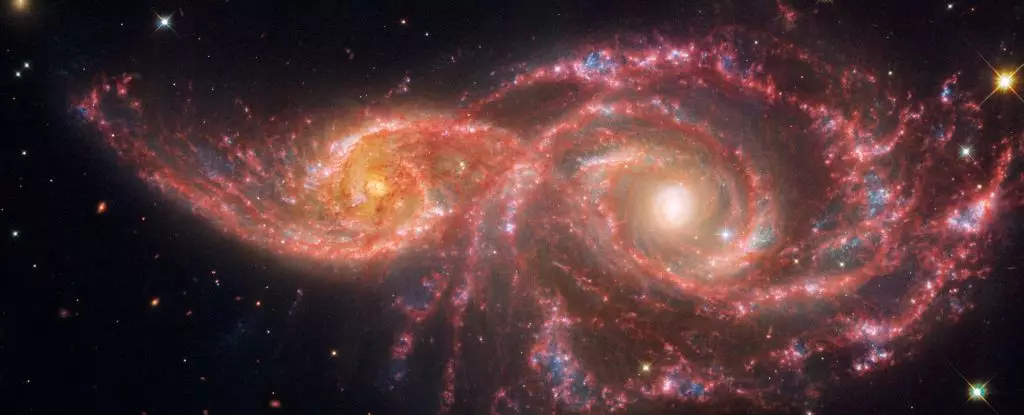When Friedrich Nietzsche asserted in 1886 that “if you gaze for long into an abyss, the abyss gazes also into you,” he likely did not foresee the profound ways in which this philosophical introspection would morph into an astronomical metaphor. Fast forward nearly 140 years, and we find ourselves staring into the vastness of space, contemplating an image captured 80 million light-years away. This celestial snapshot appears to tell a story of turmoil and transformation, mimicking the haunting gaze of two galaxies—NGC 2207 and IC 2163—caught in the throes of a cosmic collision. The artistic semblance of ominous eyes gazing back at us from the regions of deep space compels us to reflect not only on the universe but also on our place within it.
The Grand Collision: More Than Just a Cataclysm
The merging of these two galaxies is not a momentary cataclysm; rather, it comprises an intricate dance that unfolds over millions of years. In this ongoing spectacle, galaxies swing and spiral around one another, akin to partners in a cosmic ballet. The alliance between NGC 2207 and IC 2163 has been developing for some time; they have already skimmed past each other in a past encounter. Presently, they are locked in another gradual orbit, their eventual convergence still years away. Although both galaxies retain distinct spiral structures at this stage, their gravitational interplay results in profound changes, illuminating the depths of space with newfound star formation.
As these galaxies draw closer, they incite dramatic reactions within their intertwined interstellar gas clouds. The violent compression and shockwaves reverberate through space, catalyzing a frenzy of star formation. In stark contrast to our relatively placid Milky Way, which produces a modest number of new stars annually, this budding alliance births stars with exuberance—potentially generating dozens of solar masses each year. This is not merely a cycle of creation; it is a cycle of life and death, with significant star births ultimately leading to the spectacular deaths of giants in cataclysmic supernovae, enriching the surrounding gas and fueling further stellar births.
Visual Wonders: Unveiling Interstellar Aesthetics
The rich tapestry of this cosmic drama is brilliantly rendered in imagery captured by both the Hubble Space Telescope and the James Webb Space Telescope. The Hubble’s ultraviolet observations reveal regions teeming with youthful star formations, depicted in a vivid palette of bright, pale blue. These zones denote hotspots of stellar activity where opulent quantities of stars are being birthed. In concert, the JWST’s mid-infrared capabilities provide a valuable perspective on the intricate dust distribution across each galaxy. Such cobweb-like filaments illustrate not only the complexity of cosmic structures but also hint at the hidden mechanisms at work behind the scenes of stellar evolution.
In observing these profound celestial interactions, Nietzsche’s conception of the abyss takes on new dimensions. As we peer into the depths of space, we inevitably confront our own insignificance amidst a vast universe engaged in perpetual creativity and destruction. The universe stands as a testament to complexity and grandeur, far removed from the confines of our human experiences. Perhaps a revised interpretation of Nietzsche’s words could be offered: in gazing into the cosmic abyss, we not only become aware of our own smallness but also get an intimate glimpse into the astonishingly alien processes of galactic life.
Ultimately, the saga of NGC 2207 and IC 2163 serves as a reminder of the interconnectedness of all cosmic entities and the ongoing narrative of creation that transcends individual existence. As these two galaxies continue their slow, majestic merger, they illustrate an age-old truth: the universe is a dynamic, ever-evolving tapestry woven from threads of formation and destruction. As we remain onlookers—contemplating the dance of galaxies—we might draw from its immensity the insight that our individual narratives are but minor notes in the colossal symphony of existence.


Leave a Reply